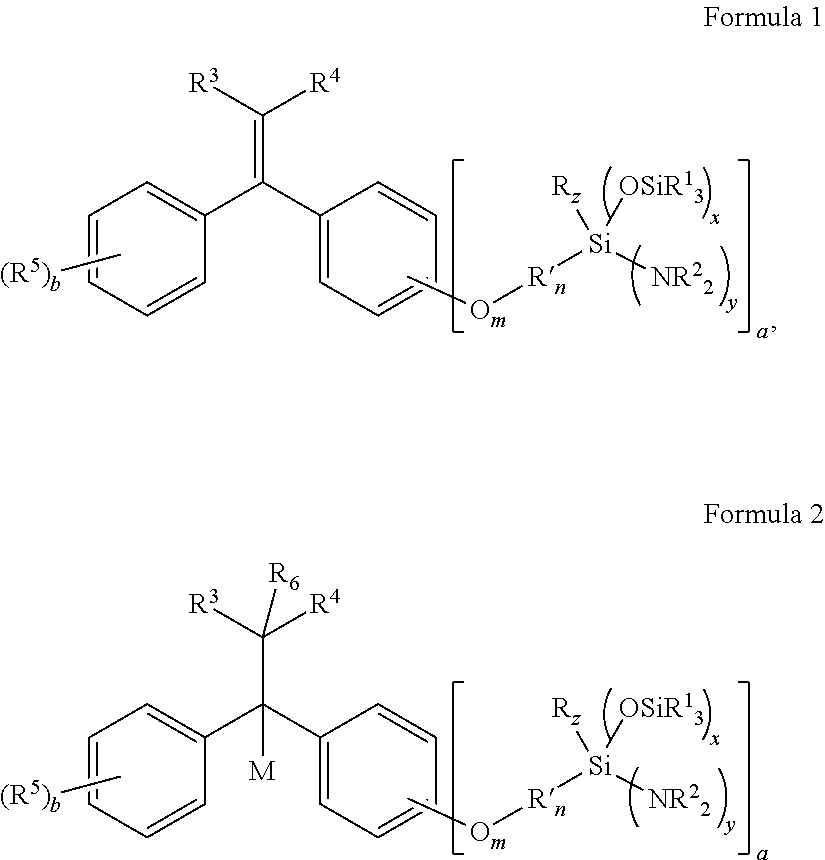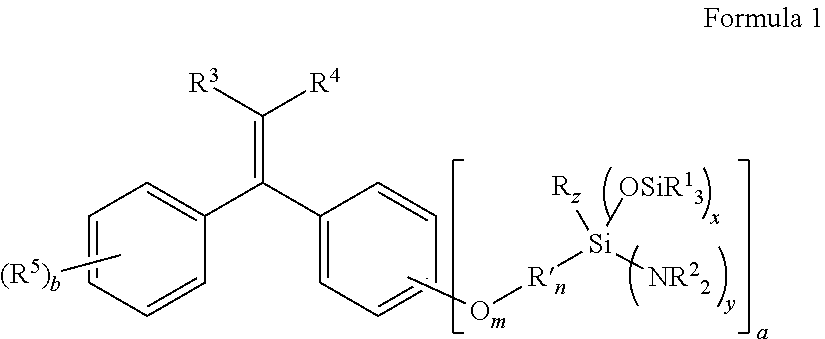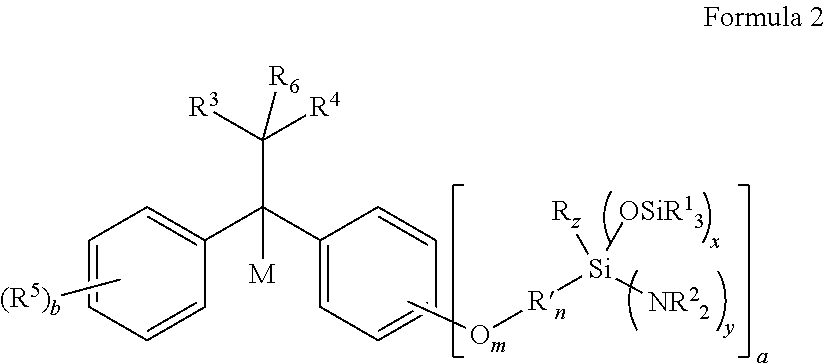Aminosilyl-Substituted Diarylethene Compounds for Anionic Polymerisation
a technology of anionic polymerisation and diarylethene, which is applied in the field of aminosilylsubstituted diarylethene compounds, can solve the problems of vulcanized elastomeric polymers, pronounced hysteresis, and loss of energy transmitted to this section of polymers, and achieves improved tan , improved abrasion resistance, and reduced heat build-up
- Summary
- Abstract
- Description
- Claims
- Application Information
AI Technical Summary
Benefits of technology
Problems solved by technology
Method used
Image
Examples
examples
[0160]The following examples are provided in order to further illustrate the invention and are not to be construed as limiting.
[0161]The molecular weight analyses were carried out by SEC / RI using a HEWLETT PACKARD HP 1100. The eluent THF was degassed on line. The solvent flow rate was 1.0 ml / min. 100 μL of polymer solution were injected per analysis. The analyses were carried out at 40° C. The molecular weights were initially calculated based on a polystyrene calibration and given in the tables as polystyrene. The real molecular weights (SSBR molecular weights) were determined dividing by a factor derived from an earlier comparison between molecular weights from SEC / RI and SEC / MALLS. The value of the factor depends on the polymer composition (styrene and butadiene content). A factor of 1.52 was used for SSBR with 21% and 25% styrene. Mp (as SSBR) was used for the calculation of TMEDA molar ratios.
[0162]NMR spectroscopy was performed on a BRUKER Avance 400 in a 5 mm BBO probe. Solven...
example a
[0316]Cyclohexane (4259.2 g), butadiene (625.7 g) and styrene (171.6 g) were charged to an airfree 10 1 reactor and the stirred mixture was heated up to 40° C. Then TMEDA (0.24 g) was added and n-butyllithium was charged dropwise to react the impurities until the color of the reaction mixture changed to yellowish (titration). After that the recipe amount of L1 (4.01 mmol, c=0.193 mol / kg) in cyclohexane corresponding to the target molecular weight of the polymer was charged immediately to start the polymerization. The start time of the charge of the initiator was used as the start time of the polymerization. Parallel the temperature was increased by heating or cooling in the wall of the reactors beginning with the charge of the initiator to the final polymerization temperature of 60° C. for 80 min. Then butadiene (3.3 g) was charged followed by SnCl4 (0.28 mmol) and 50 g cyclohexane via cylinder. The reaction was allowed to complete within 15 minutes followed by the last addition of ...
reference example b
[0317]Cyclohexane (3979.7 g), butadiene (579.5 g) and styrene (158.5 g) were charged to an airfree 10 1 reactor and the stirred mixture was heated up to 40° C. Then TMEDA (0.22 g) was added and n-butyllithium was charged dropwise to react the impurities until the color of the reaction mixture changed to yellowish (titration). After that the recipe amount of L2 (5.29 mmol, c=0.201 mol / kg) in cyclohexane corresponding to the target molecular weight of the polymer was charged immediately to start the polymerization. The start time of the charge of the initiator was used as the start time of the polymerization. Parallel the temperature was increased by heating or cooling in the wall of the reactors beginning with the charge of the initiator to the final polymerization temperature of 60° C. for 80 min. Then butadiene (3.1 g) was charged followed by SnCl4 (0.26 mmol) and 50 g cyclohexane via cylinder. The reaction was allowed to complete within 15 minutes followed by the last addition of ...
PUM
| Property | Measurement | Unit |
|---|---|---|
| glass transition temperature | aaaaa | aaaaa |
| glass transition temperature | aaaaa | aaaaa |
| hysteresis loss | aaaaa | aaaaa |
Abstract
Description
Claims
Application Information
 Login to View More
Login to View More - R&D
- Intellectual Property
- Life Sciences
- Materials
- Tech Scout
- Unparalleled Data Quality
- Higher Quality Content
- 60% Fewer Hallucinations
Browse by: Latest US Patents, China's latest patents, Technical Efficacy Thesaurus, Application Domain, Technology Topic, Popular Technical Reports.
© 2025 PatSnap. All rights reserved.Legal|Privacy policy|Modern Slavery Act Transparency Statement|Sitemap|About US| Contact US: help@patsnap.com



